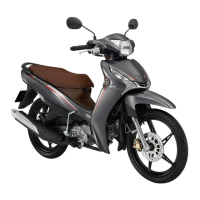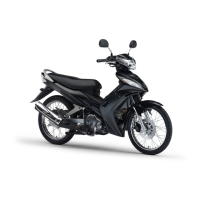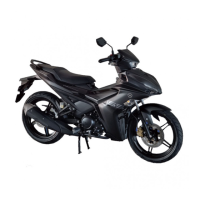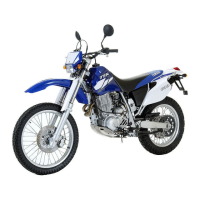Do you have a question about the Yamaha T115FL-2P and is the answer not in the manual?
Instructions to read the manual before operating the vehicle for safety.
Manual must be kept with the vehicle for future reference and safety.
Welcoming message to new owners of Yamaha motorcycles.
Critical safety warning to read the manual carefully and completely before operation.
Explanation of how important information is highlighted using notations.
Copyright and edition information for the owner's manual.
Emphasizes understanding vehicle labels for safe and proper operation.
Content of the Thai warning label.
Tire pressure specifications for different load conditions.
Owner's responsibility for safe operation, including proper techniques and maintenance.
Guidelines for safe riding, including pre-operation checks and visibility.
Guidelines for loading cargo and accessories to maintain stability and avoid accidents.
Warnings about aftermarket parts and modifications affecting safety and vehicle performance.
Instructions for safely transporting the motorcycle on another vehicle.
Importance of wearing approved helmets and proper usage.
Different helmet types and their suitability for various riding speeds.
Identification of parts on the left side of the motorcycle with page references.
Identification of parts on the right side of the motorcycle with page references.
Overview of handlebar controls and instrument panel components.
Operation and functions of the main switch and steering lock.
Instructions for opening and closing the keyhole cover.
Explanation of various indicator lights and warning signals on the instrument panel.
Explanation of the speedometer and odometer functions.
How to read and use the fuel gauge.
Description and operation of left and right handlebar switches.
Location and operation of the shift pedal.
Location and operation of the front brake lever.
Location and operation of the rear brake pedal.
Instructions for removing and installing the fuel tank cap.
Information about recommended fuel, capacity, and precautions.
Information about the catalytic converter and related warnings.
How to use the kickstarter to start the engine.
Instructions for opening and closing the seat.
Location and usage of helmet holders.
Location and care of the storage compartment.
Location and operation of the sidestand.
Pre-operation checks for fuel, engine oil, and brake systems.
Pre-operation checks for drivetrain, chassis, and tire systems.
Pre-operation checks for controls, cables, and electrical systems.
Step-by-step instructions for starting and warming up a cold engine.
Explanation of gear shifting, including throttle control and neutral position.
Advice on how to improve fuel efficiency through riding habits.
Guidelines for the engine break-in period to ensure longevity.
Safe parking procedures and considerations for hot components.
Description and purpose of the owner's tool kit.
Maintenance schedule for emission control system components.
Comprehensive chart for general maintenance and lubrication tasks.
Maintenance and checks for tires and wheel bearings.
Maintenance and lubrication for drive chain and swingarm pivots.
Lubrication for steering bearings, chassis fasteners, and pivot shafts.
Checks for sidestand, centerstand, front fork, and shock absorbers.
Maintenance schedule for engine oil and filter changes.
Checks for brake switches, cables, throttle grip, lights, and signals.
Information on air filter replacement and cleaning.
Service intervals for hydraulic brake fluid and components.
Instructions for removing and installing body panels and cowlings.
Instructions for removing and installing Panel A.
Instructions for removing and installing Panel B.
Steps for checking, gapping, and replacing the spark plug.
Procedures for checking engine oil level and changing oil/filter.
Detailed steps for changing engine oil and replacing the oil filter.
Instructions for replacing the air filter and cleaning check hoses.
Procedure for checking and adjusting the engine idling speed.
Steps to measure and adjust throttle grip free play.
Importance of checking and adjusting valve clearance, especially when cold.
Importance of tire maintenance, condition, and replacement.
Checking and adjusting tire pressure for safety and performance.
How to inspect tires for wear, damage, and tread depth.
Information about approved tire types and sizes.
Checks for wheel damage, spoke looseness, and balancing.
Procedure for adjusting brake pedal free play.
Checking and adjusting brake light switches.
Procedures for checking front brake pads and rear brake shoes for wear.
How to check brake fluid level and important precautions.
Instructions for changing brake fluid and related components.
How to check and adjust drive chain slack.
Detailed steps for adjusting drive chain slack.
Steps for cleaning and lubricating the drive chain.
Checking control cables and lubricating them.
Checking throttle grip operation and lubricating the cable.
Checking brake lever operation and lubricating the pivot.
Checking brake pedal operation and lubricating the pivot.
Checking and lubricating centerstand and sidestand pivots.
Lubrication schedule for swingarm pivots.
Checking the front fork's condition and operation.
Checking steering bearings for wear or looseness.
Checking front and rear wheel bearings for play or smooth operation.
Information on the VRLA battery, lead connections, and charging.
Procedure for replacing blown fuses safely.
Steps for replacing the headlight bulb, with precautions.
Procedure for replacing tail and brake light bulbs.
Procedure for replacing front turn signal bulbs.
Procedure for replacing rear turn signal bulbs.
Introduction to troubleshooting common issues.
A chart to help diagnose problems with fuel, battery, ignition, and compression.
Continuation of the troubleshooting chart.
General advice on caring for the motorcycle to prevent rust and corrosion.
Guidelines and precautions for cleaning the motorcycle.
Cleaning procedures after normal riding conditions.
Special cleaning procedures for corrosive environments.
Advice for short-term and long-term motorcycle storage.
Specific instructions for short-term storage.
Detailed procedures for long-term storage, including engine protection.
Physical dimensions of the motorcycle.
Curb weight of different models.
Engine specifications like combustion cycle, cooling, valve train, displacement.
Recommended spark plug type and gap.
Clutch type specifications.
Primary and secondary reduction ratios, final drive.
Frame type, caster angle, trail.
Specifications for the front tire.
Specifications for the rear tire.
Maximum load capacity.
Tire pressure recommendations for different load conditions.
Front wheel type and rim size.
Rear wheel type and rim size.
Front brake type and fluid specification.
Rear brake type.
Front suspension type and wheel travel.
Rear suspension type.
Wattage for various indicator lights.
Specifications for main, light, and signaling system fuses.
Importance of recording vehicle and engine identification numbers for service and security.
Location of the vehicle identification number.
Location of the engine serial number.
Information on ECU data storage for diagnostics and research.
Instructions to read the manual before operating the vehicle for safety.
Manual must be kept with the vehicle for future reference and safety.
Welcoming message to new owners of Yamaha motorcycles.
Critical safety warning to read the manual carefully and completely before operation.
Explanation of how important information is highlighted using notations.
Copyright and edition information for the owner's manual.
Emphasizes understanding vehicle labels for safe and proper operation.
Content of the Thai warning label.
Tire pressure specifications for different load conditions.
Owner's responsibility for safe operation, including proper techniques and maintenance.
Guidelines for safe riding, including pre-operation checks and visibility.
Guidelines for loading cargo and accessories to maintain stability and avoid accidents.
Warnings about aftermarket parts and modifications affecting safety and vehicle performance.
Instructions for safely transporting the motorcycle on another vehicle.
Importance of wearing approved helmets and proper usage.
Different helmet types and their suitability for various riding speeds.
Identification of parts on the left side of the motorcycle with page references.
Identification of parts on the right side of the motorcycle with page references.
Overview of handlebar controls and instrument panel components.
Operation and functions of the main switch and steering lock.
Instructions for opening and closing the keyhole cover.
Explanation of various indicator lights and warning signals on the instrument panel.
Explanation of the speedometer and odometer functions.
How to read and use the fuel gauge.
Description and operation of left and right handlebar switches.
Location and operation of the shift pedal.
Location and operation of the front brake lever.
Location and operation of the rear brake pedal.
Instructions for removing and installing the fuel tank cap.
Information about recommended fuel, capacity, and precautions.
Information about the catalytic converter and related warnings.
How to use the kickstarter to start the engine.
Instructions for opening and closing the seat.
Location and usage of helmet holders.
Location and care of the storage compartment.
Location and operation of the sidestand.
Pre-operation checks for fuel, engine oil, and brake systems.
Pre-operation checks for drivetrain, chassis, and tire systems.
Pre-operation checks for controls, cables, and electrical systems.
Step-by-step instructions for starting and warming up a cold engine.
Explanation of gear shifting, including throttle control and neutral position.
Advice on how to improve fuel efficiency through riding habits.
Guidelines for the engine break-in period to ensure longevity.
Safe parking procedures and considerations for hot components.
Description and purpose of the owner's tool kit.
Maintenance schedule for emission control system components.
Comprehensive chart for general maintenance and lubrication tasks.
Maintenance and checks for tires and wheel bearings.
Maintenance and lubrication for drive chain and swingarm pivots.
Lubrication for steering bearings, chassis fasteners, and pivot shafts.
Checks for sidestand, centerstand, front fork, and shock absorbers.
Maintenance schedule for engine oil and filter changes.
Checks for brake switches, cables, throttle grip, lights, and signals.
Information on air filter replacement and cleaning.
Service intervals for hydraulic brake fluid and components.
Instructions for removing and installing body panels and cowlings.
Instructions for removing and installing Panel A.
Instructions for removing and installing Panel B.
Steps for checking, gapping, and replacing the spark plug.
Procedures for checking engine oil level and changing oil/filter.
Detailed steps for changing engine oil and replacing the oil filter.
Instructions for replacing the air filter and cleaning check hoses.
Procedure for checking and adjusting the engine idling speed.
Steps to measure and adjust throttle grip free play.
Importance of checking and adjusting valve clearance, especially when cold.
Importance of tire maintenance, condition, and replacement.
Checking and adjusting tire pressure for safety and performance.
How to inspect tires for wear, damage, and tread depth.
Information about approved tire types and sizes.
Checks for wheel damage, spoke looseness, and balancing.
Procedure for adjusting brake pedal free play.
Checking and adjusting brake light switches.
Procedures for checking front brake pads and rear brake shoes for wear.
How to check brake fluid level and important precautions.
Instructions for changing brake fluid and related components.
How to check and adjust drive chain slack.
Detailed steps for adjusting drive chain slack.
Steps for cleaning and lubricating the drive chain.
Checking control cables and lubricating them.
Checking throttle grip operation and lubricating the cable.
Checking brake lever operation and lubricating the pivot.
Checking brake pedal operation and lubricating the pivot.
Checking and lubricating centerstand and sidestand pivots.
Lubrication schedule for swingarm pivots.
Checking the front fork's condition and operation.
Checking steering bearings for wear or looseness.
Checking front and rear wheel bearings for play or smooth operation.
Information on the VRLA battery, lead connections, and charging.
Procedure for replacing blown fuses safely.
Steps for replacing the headlight bulb, with precautions.
Procedure for replacing tail and brake light bulbs.
Procedure for replacing front turn signal bulbs.
Procedure for replacing rear turn signal bulbs.
Introduction to troubleshooting common issues.
A chart to help diagnose problems with fuel, battery, ignition, and compression.
Continuation of the troubleshooting chart.
General advice on caring for the motorcycle to prevent rust and corrosion.
Guidelines and precautions for cleaning the motorcycle.
Cleaning procedures after normal riding conditions.
Special cleaning procedures for corrosive environments.
Advice for short-term and long-term motorcycle storage.
Specific instructions for short-term storage.
Detailed procedures for long-term storage, including engine protection.
Physical dimensions of the motorcycle.
Curb weight of different models.
Engine specifications like combustion cycle, cooling, valve train, displacement.
Recommended spark plug type and gap.
Clutch type specifications.
Primary and secondary reduction ratios, final drive.
Frame type, caster angle, trail.
Specifications for the front tire.
Specifications for the rear tire.
Maximum load capacity.
Tire pressure recommendations for different load conditions.
Front wheel type and rim size.
Rear wheel type and rim size.
Front brake type and fluid specification.
Rear brake type.
Front suspension type and wheel travel.
Rear suspension type.
Wattage for various indicator lights.
Specifications for main, light, and signaling system fuses.
Importance of recording vehicle and engine identification numbers for service and security.
Location of the vehicle identification number.
Location of the engine serial number.
Information on ECU data storage for diagnostics and research.
| Brand | Yamaha |
|---|---|
| Model | T115FL-2P |
| Category | Motorcycle |
| Language | English |











